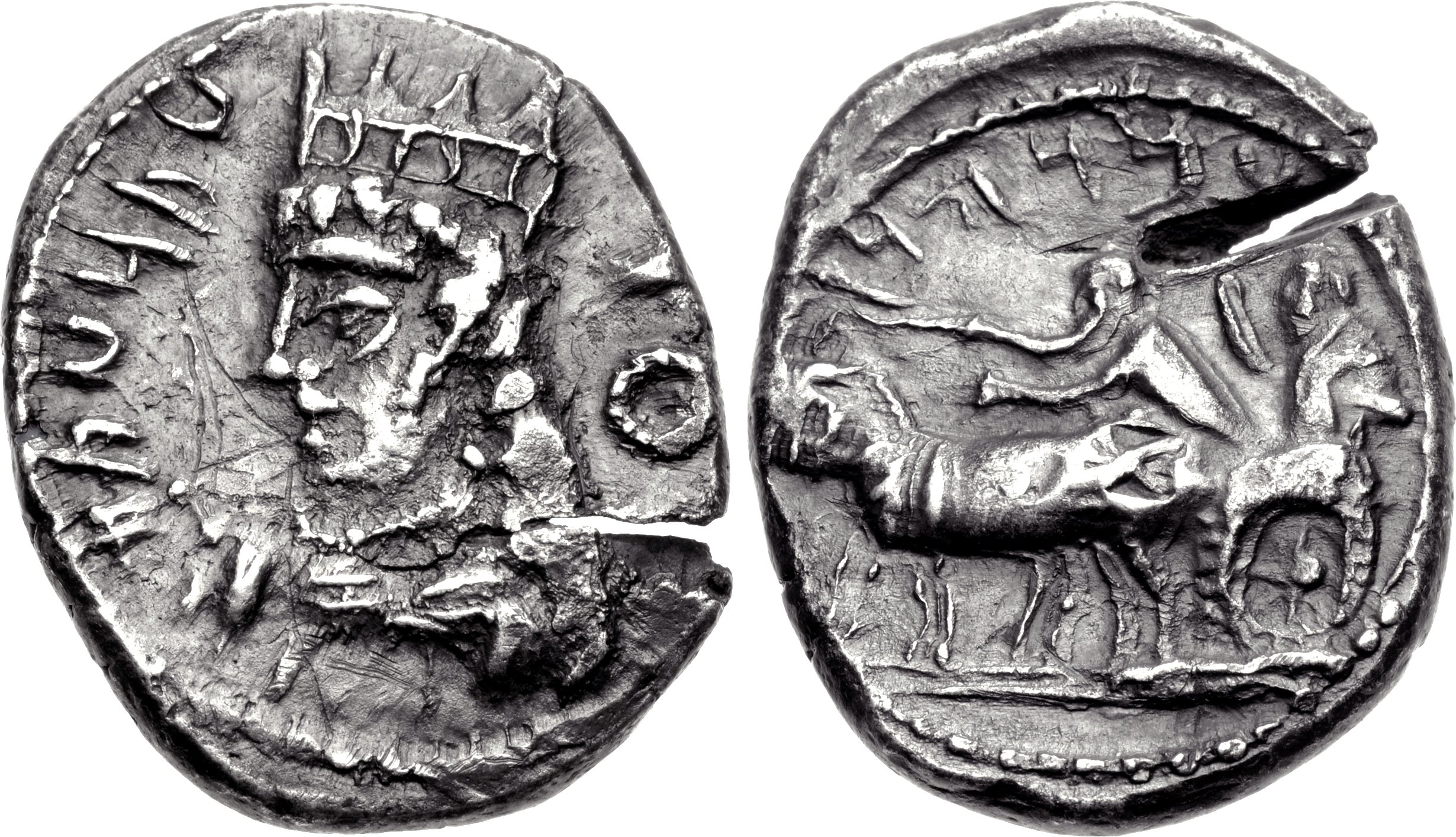S 2046 - Hierapolis-Bambyke, silver, didrachms (profile head/chariot) (342-331 BCE)
From SILVER
342 BCE - 331 BCE Silver 1,863 kg
Description
| ObverseInscription or printing placed on the obverse.: | Aramaic ‘tr‘th (Atarateh) to left (Aramaic).Draped bust of Atargatis left, wearing turreted crown, crescent and circle to right |
| ReverseInscription or printing placed on the reverse.: | Aramaic ‘bdhdd (Abdhadad) above (Aramaic).Great King and driver, who holds reins in both hands, in quadriga of mules left, countermark on horse: Aramaic alef in incuse square |
Mint and issuing power
| MintIdentifies the place of manufacture or issue of a numismatic object.: | Hierapolis-Bambyke | Ancient regionAncient region.: | Syria | Modern countryModern country: Syria | AuthorityIdentifies the issuing power. The authority can be "pretended" when the name or the portrait of X is on the coin but he/she was not the issuing power. It can also be "uncertain" when there is no mention of X on the coin but he/she was the issuing power according to the historical sources: | Abd-Hadad of Hierapolis, Persian Empire |
Chronology
| FromIdentifies the initial date in a range assigned in a numismatic context. | 342 BCE | toIdentifies the final date in a range assigned in a numismatic context.. | 331 BCE | PeriodTime period of the numismatic object.: Classical 480-323 BC |
Physical description
| MetalThe physical material (usually metal) from which an object is made.: | Silver |
Median weightMedian of the weights of numismatic objects (in grams). in grams | 8.20 | DenominationTerm indicating the value of a numismatic object. Examples: tetradrachm, chalkous, denarius.: | didrachm |
StandardStandard.: |
Image

S2046 Bambyke chariot tiara.jpg [1]
References
| Die study referencePublication of the study: | Andrade 20171Andrade 2017, p. 30-33 (Series 2-4) | ||
| Coin series referenceReference to coin series study: | HGC 92HGC 9, n° 1342 | ||
| Coin series web referenceCoin series web references: | |||
Obverse dies distribution
| FrequencyFrequency of specimen in distribution. ᵖ | Number of obversesNumber of obverse dies. ᵖ (o) | % (o) | Number of coinsNumber of coins. (n) | % (n) | Die nameName(s) of the die(s). |
| 1 | 4 | 57.14 | 4 | 28.57 | 2/1, 3/1, 4/1, 4/3 |
| 2 | 1 | 14.29 | 2 | 14.29 | 2/2 |
| 3 | 1 | 14.29 | 3 | 21.43 | 3/2 |
| 5 | 1 | 14.29 | 5 | 35.71 | 4/2 |
| Total | 7 of 7 | 100.01 | 14 of 14 | 100 |
Reverse dies distribution
no distribution is available
Quantification
| Number of obversesNumber of obverse dies. ᵖ (o) | 7 | Number of singletons (o1)The number of singleton coins. ᵖ | 4 |
| Number of reverse diesNumber of reverse dies. (r) | 11 | Number of coinsNumber of coins. (n) | 14 |
| Coins per obverse dieNumber of coins per obverse die. (n/o) | 2 | Coins per reverse dieNumber of coins per reverse die. (n/r) | 1.27 |
| Reverse per obverse ratioRatio of obverse dies divided by reverse dies. (r/o) | 1.57 | Percentage of singletons (o1)number of coins (n) divided by the number of singletons (o1) ᵖ | 57.14 % |
| Original number of dies (O) (Carter 1983 formula)The estimation of the number of coins according to Carter 1983 ᵖ | 11.36 | Coins struck if 20,000 as average productivity per dieCoins made if the average productivity for obverses (according to Carter) is 20,000. ᵖ | 227,200 |
| Original number of dies (O) (Esty 2011 formula)The estimation of the number of coins according to the singleton formula in Esty 2011 ᵖ (O) | 14 | Survival rate if 20,000 as average productivity per dieSurvival rate if average productivity is 20,000. ᵖ | 0.00006 |
| Coverage (o = % of O) (Esty 1984 formula)Esty 1984 - coverage (% of O) ᵖ (o = % of O) | 71.43% | Die productivity if survival rate 1/2,000Average productivity if survival rate is 1/2,000. ᵖ | 2,464.79 |
| Weight of silver (in kg) if 20,000 coins per die (O = Carter formula)Carter 1983 * Median weight * 20000 (*10 if gold or electrum) ᵖ | 1,863 kg <br /> 1,863 kg | Die productivity if survival rate 1/5,000Average productivity if survival rate is 1/5,000. ᵖ | 6,161.97 |
Remarks